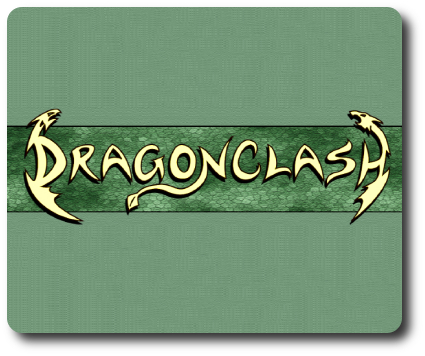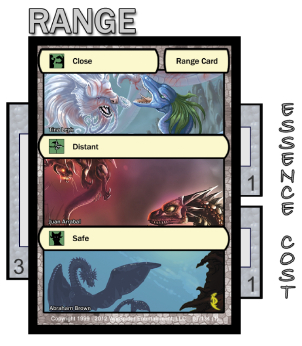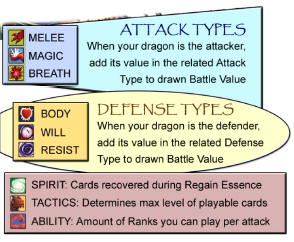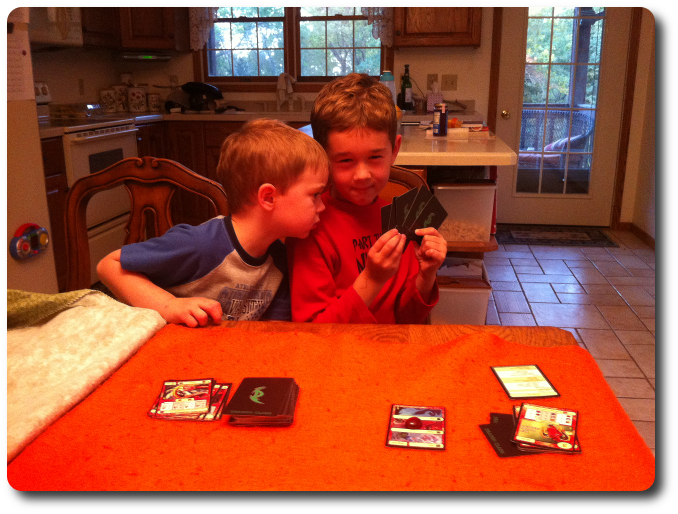GD Star Rating
loading...

The Basics:
- For ages 8 and up
- For 2 players
- Approximately 30 minutes to complete
Geek Skills:
- Counting & Math
- Logical & Critical Decision Making
- Reading
- Pattern/Color Matching
- Strategy & Tactics
- Risk vs. Reward
- Hand/Resource Management
Learning Curve:
- Child ? Moderate
- Adult ? Easy
Theme & Narrative:
- Take on the role of a young dragon who must fight to survive!
Endorsements:
- Gamer Geek approved!
- Parent Geek approved!
- Child Geek approved!
Overview
Earth trembled and shuddered in anguish. After countless centuries and generations, mankind had finally dug too far, spoiled too much, and loved too little. The war-torn land was ravaged and the living spirit of nature, known as Gaia, summoned forth protectors of old to bring the fractured world into balance. These ancient and powerful dragons were the living embodiment of the rawest elements of life and death, but something was amiss. Because of their close connection to nature, their birth was laced with the madness that had consumed the world. Now the dragon champions of Earth battle each other for?supremacy?and all of creation is at their mercy.
Dragon Clash, by WarSpider Entertainment (LCC), is a card game comprised of a full deck of fixed cards that represent a specific dragon breed. In total, there are four breeds of dragons that each have a unique style of play that represent the dragon breed?s natural strategy and tactics. The four dragons include the Red Breather, the Blue Adept, the Silver Channeler, and the Brown Mauler. Each deck contains 1 Dragon Egg card, 1 Range card, 1 Rules Summary card, 8 Dragon Age cards, and 60 Dragon Action cards, for a total of 71 cards. One deck is required for each player, both of which can be the same dragon breed. Since?Dragon Clash is not a collectible card game (CCG), you only need to buy the decks once. Not included with the decks, but required to play, are the rules (which are freely available online and you must print off yourself) and at least 2 markers that are used with the Range cards, one per player.
The artwork and card format is excellent and easy to understand after reading the rules. Some of the cards, especially the Dragon Age cards (which represent the dragon at different growth stages) are very icon heavy. They are logically grouped, however, and easy to learn. Based on the number of icons and additional text on the cards, the learning curve is slightly higher for child geeks and inexperience non-gamers. An optional reference card sheet can be downloaded and printed that does an excellent job of summarizing the icons and their use, making the document an excellent tool to use when teaching the game and for quick reference during game play.
Game Set Up
To set up the game, first have each player sit across from each other and select one full deck of cards that represents the dragon breed of their choice. Again, it is perfectly fine if both players have the same dragon breed as the individual cards of each player?s deck never get mixed with their opponents. It is, however, more fun to play with different dragons as each dragon brings something slightly different to the table.
Second, have each player find and set aside the?Dragon Egg card, the Range card, the Rules Summary card, and the 8 Dragon Age cards. The remaining Dragon Action cards should now be shuffled thoroughly and set temporarily aside, face-down. Leave room next to this deck for a discard pile.
Third, organize the Dragon Age cards in sequential order, with ?1? at the top, ?2? below that, and so on until all eight cards are sorted sequentially. This is the player?s Dragon Age deck and is placed to one side of the player?s playing area (player?s choice).
Fourth, the Range card is placed to one side of the player?s playing area and the marker is placed in the ?Close? position at this time. Player?s should place the Rules Summary card wherever they like.
Fifth, draw 7 Dragon Action cards and add the Dragon Egg card to create a hand of 8 cards. Players should keep their hand hidden from their opponent at all times.
Sixth, each player now draws the top card from their Dragon Action deck and compares each card?s Battle Value (noted on the card?s upper left-hand corner with crossed swords). The player with the highest value goes first. These cards are then placed on the bottom of the Dragon Action deck, not the discard pile.
Play now begins with the first player. Ready! Fight!
A War of Dragons
Each player?s turn involves 6 steps taken in sequential order. They are briefly described here. We encourage you to read the rules, which are free to download, from the game?s?official?web site for all the details.
Step 1: Regain Essence
Dragon essence is like a dragon?s stamina and it comes from the Dragon Action deck.?Throughout?the game, players will be discarding cards to their Dragon Action discard pile. This represents used essence, but the dragon can gain it back. Depending on the dragon?s current Spirit value, they will be able to draw a certain number of cards from the top of their Dragon Action discard pile and place them in any order back in the Dragon Action deck at the bottom. Additional cards in the game allow the Spirit value to slightly?fluctuate?per round, but the number of cards the player gets to retrieve is largely dependent on the dragon?s current growth stage. For example, the Blue Adept dragon?hatching has a Spirit value of ?1?, but the elder wyrm has a Spirit of ?4?.
Step 2: Draw a Card
The player draws 1 card from their Dragon Action deck and adds it to their hand. If the player does not have any cards in their Dragon Action deck (which is possible as the game progresses), this step is skipped.
Step 3: Resolve Range
The distance between the warring dragons can shift every round. Depending on the distance from the dragon?s target, a benefit can be gained that will either help the attacker or the defender. Shifting position costs essence, however, meaning the player will be forced to discard cards from their Dragon Action deck. Note that staying in the same position as the last round does not cost any essence.

Depending on where the marker is currently located on the Range card and where the player wants to move, the amount of essence will differ. Once the player does decide, they move their marker to the new position (if they move at all) on their Range card and discard a number of Dragon Action cards to the discard pile. If the player does not have enough cards to discard, they cannot move to the new range. Once the active player has moved their marker on the Range card, their opponent matches the range on their card, but does not pay any essence cost for doing so. This is done to ensure that both players know the exact range they are from each other.
After range has been resolved, starting with the active player, Burst cards can be played to adjust the range. This is done by each player taking alternating turns until each player is done playing a burst. Burst cards allow the player to subtly move their dragon to gain the upper hand in combat. If a Burst card is played, it is simply discarded to the player?s discard pile, the range is adjusted accordingly, and any additional card text is followed. Note, however, that a player can only play Burst cards if the card?s Tactic Value is equal to or lesser than the player?s current dragon?s Tactic Value (which?fluctuates?with the dragon?s growth stage) and if the current Range Value is equal to or closer than the one indicated on the card.
Step 4: Take Actions
The player is now given 2 actions in total. Each card played takes 1 action.
Event, Gift, Attack, or Effect cards are played to the table, but players need to always check if their dragon?s current growth stage allows for a card?s specific Tactic Value. Range Values are ignored at this time for Attack Cards.
- Event cards shape the battle ground and can impact both or only one of the players. Only 1 Event card can ever be in play at a time between both players, meaning a new Event card trumps the old one, replacing it, and becomes the new Event card.
- Gift cards provide the dragon with a special benefit. Each player can only have?1 Gift card in play at a time for their dragon, meaning a new Gift card trumps the old one, replacing it, and becomes the new Gift card.
- Attack cards stack and each Attack card of the same attack type adds 1 additional rank to the total. The number of Attack cards that can be played is limited by the dragon?s current Ability Value. For example, if the dragon?s Ability Value is 3, only a total of 3 Attack cards can be in play at the table. This means a player must carefully consider what Attack cards they want to increase in rank. A higher ranked Attack means a stronger attack, but the different attack types are only useful at specific ranges!
The player can also spend one or both of their actions to increase the dragon?s hoard and age their dragon.
- The player can Hoard one card from their hand for one action. This card is placed face-down under their current Dragon Age card. This is referred to as the Hoard pile. No more than 2 cards can ever be in the dragon?s Hoard pile at a time.
- Once 2 cards are in he Hoard pile, the dragon can age to the next level. For example, an age 3 dragon will now be an age 4 dragon. The appropriate new Dragon Age card now comes?immediately?into play along with the dragon?s new stats. The two cards in the Hoard pile are now revealed to the opponent and only one is taken back to the player?s hand, while the other is sent to the discard pile. If one of the two cards in the Hoard pile is the player?s Dragon Egg card, it must be returned to the player?s hand.
Step 5: Attack
The player may now optionally attack their opponent. The player only gets one chance to attack and must use one of their Attack cards in play. The Attack card must provide an attack that is within range. Tactic values are ignored at this time.
Once the attack is decided, the player pays the essence cost (noted next to the Attack card?s Spirit icon) by matching the attack ranking (which is determined by the number of cards of the same attack type). Opponents may play cards from their hand to?influence?the attack. Afterwards, unless the attack is canceled, each player will determine the outcome of the attack by matching Battle Values.
The attackers Battle Value is based on the attack card?s current Battle Value and added to the Battle Value of a card drawn from the Dragon Action deck, plus their dragon?s current associated attack attribute that is based on the attack type (melee, magic, or breath found on the Dragon Age card). The defender draws one card from their Dragon Action deck, too, and adds that value to their dragon?s current associated defence value that is based on the attack type they are defending. Both player?s now match their Battle Values. If the defender has a higher total Battle Value, the attack was ineffective. If the attacker?s value is larger, the defender now takes damage.

Damage is dealt and counted by discarding a number of cards from the Dragon Action deck equal to the attack damage inflicted. Once the Dragon Action deck is exhausted, the player can choose to pay the cost of the damage from their hand or take cards from their Hoard pile, placing them in the discard pile. A player should do all they can to protect their Dragon Egg card, however.
Step 6: Turn End
The player?s now determine if the endgame condition has been met and resolve any ?End of Turn? effects. Additionally, the player discards their hand down to no more than 7 cards (which can be altered by cards in play). It is now the next player?s turn starting with step 1.
An End to All Wars
In the end, one dragon will win and rule the world. Victory comes to the player whose opponent looses their Dragon Egg to their discard pile. This can only happen when the player is forced to discard it.
To learn more about?Dragon Clash and review the full rules which we have only summarized here, see the game?s official web site.
Prediction
After reading the rules, I started to get very excited about this game. Dragon Clash requires a great deal of strategy and tactics from the player. For example, should a player grow their dragon, build up their attack types, or move to a better position for a specific attack? Lots to consider! The rules make the game sound very simple to play. but there are many important decisions that need to be made. From a Gamer Geek?s perspective, this game already sounds like a winner. Depending on how ?fiddly? the game is, and the inherent learning curve that comes with use of icons in games, the Child Geeks will either find it accessible or well out of reach and?confusing.
Parent Geeks? Hmmm?.
Dragon Clash is slightly heavier than a casual tactical game, by my standards. There is a lot to think about, but not a whole lot to constantly fuss over. Hand management is a must, but once the cards are played, that?s pretty much it for them. Players will need to focus on the growth of their dragon, the constant shifting of their Dragon Action deck, and putting their discarded cards back in an order that makes sense to them, all of which essentially impacts their game in future rounds. That can ?feel? really heavy to some players (although it will more or less go over the heads of the Child Geeks who won?t give it much thought). Heavy games are not as popular with the Parent Geeks because of their lack of time to play them and the focus required to be competitive. Casual games are usually the winners, especially those games that allow groups of players to join at the table and have a good time.?Dragon Clash?is not overly casual, only takes 2 players, and will feel like work if you don?t come to the table for a battle. Then again, the game can take less than 30 minutes and there is nothing stopping the players from temporarily pausing the game to go handle screaming kids. So, at this point, I?m not altogether sure what the Parent Geeks will decide in regards to their endorsement.
Teaching the game took longer than I expected with my 8-year-old. He understood the game?s concept almost immediately, but failed to grasp the icons and their meaning throughout the game. The learning curve is not steep on this, but nor is it an easy jog down hill. Do expect to spend time with the icons and the different cards. It?s all within their grasp, but some little geeks might take longer than others. And so, after spending a few days teaching the game to him, demoing actions, and answering all of his questions, he was ready for his first dragon battle. Before we let loose the wyrms of war, I asked him his thoughts on the game so far.
?I think this is one of those games I will finally understand halfway through, but too late to do anything about it until the next game. Let?s fight!? ~ Liam (age 8)
And so it begins. Let?s find out if the battle is well worth our time or if it proves to be a foolish venture.
Final Word
As predicted, my little geek suddenly ?got it? halfway through our first game. He started to jump up and down excitedly as he quickly started to ramble off all the things he finally understood. It pleased me greatly to see him experience a ?EUREKA!? moment and become impassioned by it. He asked if we could start a new game immediately, which I was hesitant to do. I wanted him to play the current game all the way through so he could benefit from the experience. He didn?t care for this much (as he knew he was going to lose), but he agreed. Our first game resulted in me being victorious. Our second and third games were very close, our fourth was a draw, and our fifth ended with my son eating my Dragon Egg. The game greatly pleased my son, continues to hold his interest, and sparks his imagination. He is bugging me for the two other dragon decks (we have the Red Breather and Blue Adept dragon decks) and he is teaching his 5-year-old brother how to play a simpler version of the game so he can join in on the fun.
Parent Geeks surprised me and greatly enjoyed the game. Although, in hindsight, I should not have been all that surprised because this group also enjoyed?Sentinels of the Mutliverse and?Dominion. One Parent Geek was so excited about the game, they wanted to go home and buy all the decks as soon as possible. Another Parent Geek begged me to lend them the game so they could play it with their family on the east coast. The non-gamers didn?t do as well, but nor did they dislike the game. The theme wasn?t really to their liking (?warring dragons??), but they understood the rules and played well enough.
Gamer Geeks very much enjoyed this game and found the level of thought, tactics, and strategy that was needed very rewarding. One Gamer Geek considered the game an excellent exercise in army building while another considered the game to be a simulation of building a war machine. The only negative the Gamer Geeks mentioned was that it was a shame it was only a 2-player game. But at the same time, they strongly suggested that Dragon Clash deserved expansions, more dragon decks, and was perfectly poised to be a tournament-style card game.

My two little geeks plot their next move against their father?.
Gamer Geeks, this is an outstanding tactical and strategic card game that puts a great deal of emphasis on managing the growth and training of a dragon from a young hatchling to a venerable great wyrm. Then there is the combat, which requires the players to move into specific positions to use their attacks to their fullest. There are many different things to consider, but the game never feels heavy or plays slowly. Each round is an exercise in thoughtful hand management and considering the next two or three possible moves. The end result is an excellent tactical and strategical card game that plays quickly, challenges completely, and is sure to please the most geekiest of gamers.
Parent Geeks, this is an excellent game to sit down with a peer or a family member and engage in a delightful and challenging game of dragon combat. Each player will have the same objective, but how they go about it will depend on what each player considers more important. Is growing the dragon quickly the most important thing to do or should the player instead focus on training the dragon with attack types so it can defend itself? With so much to consider, you?d think the game would feel overwhelming, but it plays light and never crushes the players under countless decisions. Best of all, the game is not a?collectible?card game, meaning you won?t be spending money again and again to keep the game going.
Child Geeks, this is a challenging game that has a slight learning curve that will keep you from jumping into the game right away. But jump into the game you must! The icons are not complicated, but there are a lot of them. Using the card reference sheet will help you out a great deal and it won?t be long before the game makes sense. After that, you get to decide how best to play the game. Do you think it?s more important to grow your dragon and see it mature to a giant beast? Or do you think it is better to train your dragon with the necessary skills to dominate the battlefield? It?s totally up to you and you?ll have enough time in the game to adjust your strategy if you think you need to.
I simply adore?Dragon?Clash. It feels like a?collectible?card game without the need for me to spend my little geeks? college fund to support it, provides an entertaining challenge, and each deck requires the players to approach the game differently, while never upsetting the balance of the game itself. The game plays quickly, intelligently, and gives the players a lot of room to explore and make their own choices without ever feeling confined by rules. The game also gives the players enough time to grow their dragons (which is a lot of fun) and change their tactics as needed to react to their opponent?s choices. The end result is a game that is a great deal of fun to play, evolves as the game play continues, and feels very satisfying, win or lose.?Do play?Dragon?Clash?the first chance you get!
This game was given to Father Geek as a review copy. Father Geek was not paid, bribed, wined, dined, or threatened in vain hopes of influencing this review. Such is the statuesque and legendary integrity of Father Geek.
Dragon Clash Game Review,You might also be interested in:
- Dragon?s Bard Game Review (prepublished version)
- God Dice Game Review
- King? Critters Game Review
- Dragon Face Game Review
- Hoplomachus Game Review (prepublished version)
Source: http://fathergeek.com/reviews/dragon-clash/
texas tornado fantasy baseball st louis cardinals jared sullinger jaleel white levi johnston 2013 srt viper
No comments:
Post a Comment
Note: Only a member of this blog may post a comment.